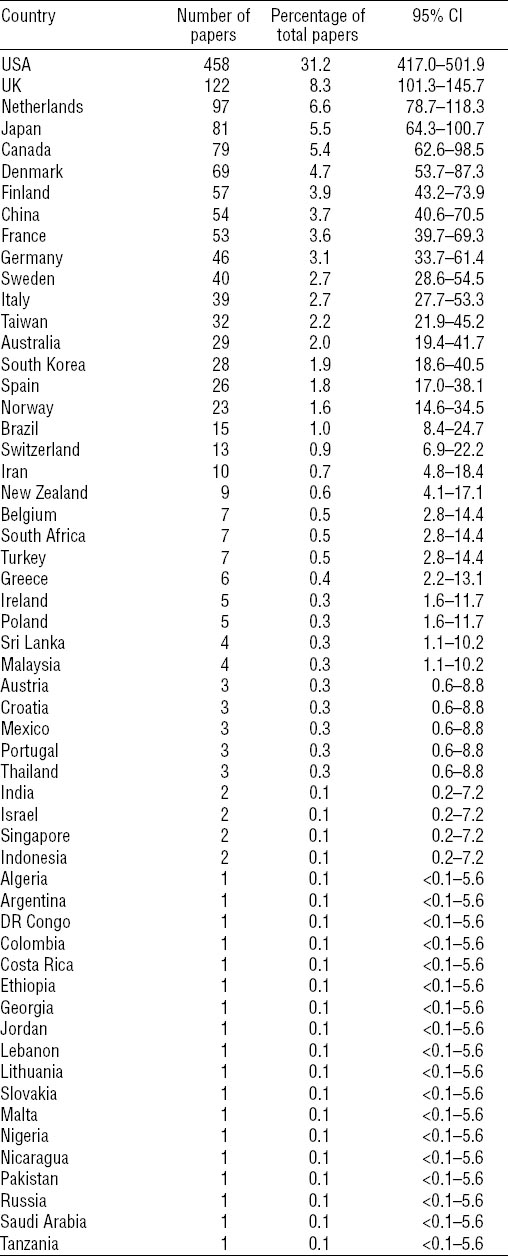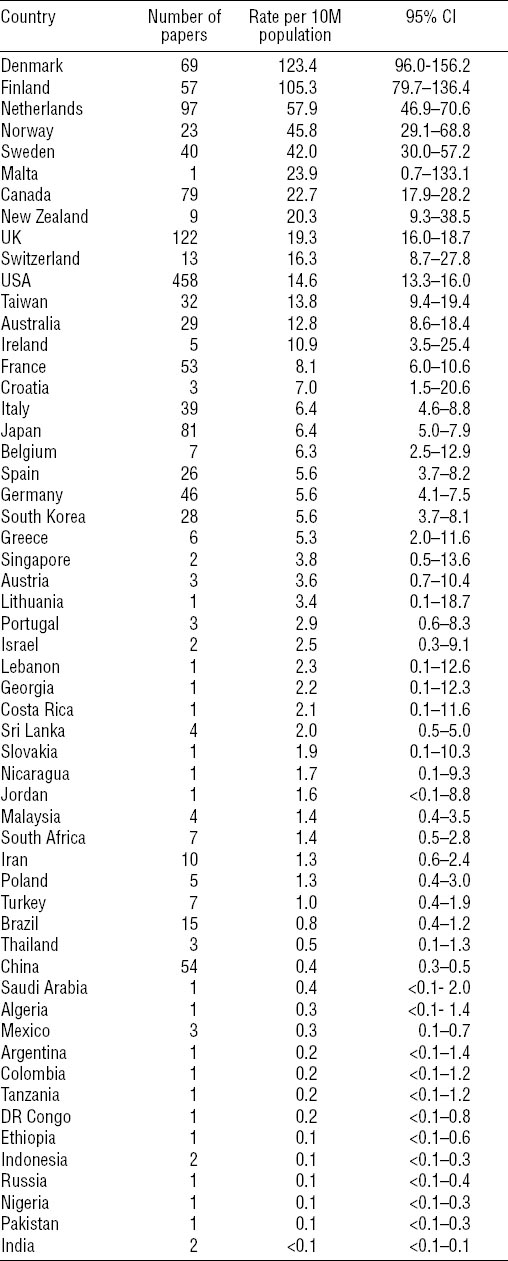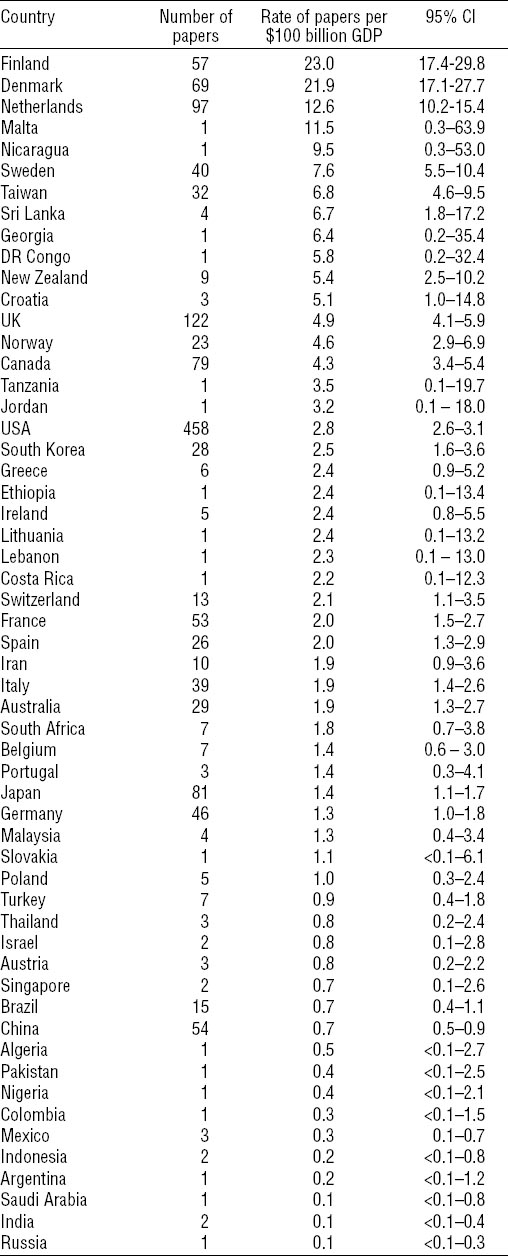In 1995, the World Health Organization (WHO) published its “Global strategy on occupational health for all”, reaffirming the importance of occupational health in achieving its aim of promoting the health of populations and individuals worldwide. One of its ten objectives was to strengthen occupational health research. It was advised that research should be included within national programs for occupational health and international collaboration be required on research (1).
Previous researchers have studied the countries of origin of occupational health research. Navarro and Martin (2) considered original research articles published in eight occupational health journals between 1992 and 2001. They recorded the numbers of papers and adjusted by countries’ population and gross domestic product (GDP). They studied 7688 articles, half of which were published in US journals. Articles originated from 84 countries, but 44% were from the USA and 86% were from just 10 countries. The dominance of the USA was less apparent in the context of numbers adjusted for population or economy size (GDP), with Scandinavian countries seeming to have a proportionately large contribution to the research base.
Soteriades and Falagas (3) used a similar methodology for a wider area of medical research in a study, published in 2006, of papers in preventative medicine, occupational/environmental medicine, epidemiology and public health. They studied 48 861 papers from 72 journals and analyzed the results using nine geographical regions. Like Navarro and Martin (2), they adjusted the data according to population and GDP of the countries. They analyzed preventative medicine and occupational/environmental medicine as one category, finding that 43% of studies came from the USA and 32% from Western Europe. The other seven regions contributed only 25%, the smallest contribution being Africa (0.8%). Analyzed by GDP, Canada was the leading region with the USA second; by population, the USA was first and Canada second. The data were not presented separately for occupational medicine or individual countries. It was concluded that these results suggest a need for the promotion of research in less developed countries.
The study by Navarro and Martin (2) on the geographic distribution of occupational health research is based on data from over ten years ago. It is unclear if there have been changes in the international distribution of occupational health research since they published their work. In order to address this shortcoming, the present study was performed to identify and describe the current proportion of published occupational health research generated from different countries.
Methods
This is a descriptive study of the bibliometrics of seven occupational health journals, selected based on their 2012 impact factors and number of citations (table 1). These seven were chosen as they had a 5-year impact factor >1.5 and >2000 citations in 2012 (4). Each research paper published in these journals in 2011 and 2012 was included in the study. Original research and reviews were included in the citation count, editorials and letters excluded. The electronic editions of the journals within the study period were accessed. It is appreciated that some papers in these journals cover occupational hygiene or environmental health topics rather than occupational health. As there is a crossover between these academic disciplines, it was decided to retain these papers.
Table 1
Bibliometric data and distribution of 1466 papers in the occupational health journals studied.

The country of origin for each paper was recorded as that of the affiliation of the first author. If an author was recorded as having an affiliation to institutions in more than one country, the first quoted was chosen.
The crude rate of publications by country was recorded as a total for all seven journals and rates were calculated based on the 2012 GDP and population for each country, using data from the World Bank (5, 6). The rates are presented in table form and as maps, created using ArcGIS 10 (www.sjweh.fi/data_repository).php. Confidence intervals were calculated for the rates using a method suitable for a sample from a Poisson distribution (7).
Results
We identified a total of 1466 papers, with first authors based in 56 different countries. The crude rates of papers classified by country, for the two year study period, are presented in table 2 for all seven journals combined.
Table 2
Number of publications per country (1466 journals) in 2012. [95% CI=95% confidence interval]

The data include publications from authors based in 56 different countries. Of these countries, 31 (55%) are in the World Bank high-income category and 25 (45%) in the middle- and low-income (developing economies) categories (8). Figure 1 (www.sjweh.fi/data_repository) shows the crude rates for all journals and the rates adjusted by GDP, represented as a map.
The data were used to calculate the rate of publications per $100 billion GDP (represented in table 3) and per 10 million population of each country (represented in table 4).
Table 4
Publication rates adjusted by population (1466 journals) in 2012. [95% CI=95% confidence interval]

The data indicate that the majority of occupational health research is produced in a relatively small number of countries, with over half of the total number of papers originating from 4 countries (USA, UK, Netherlands and Japan). The leading 10 countries contributed 76% of the total number of papers and the top 20 countries 94%.
The World Bank has 188 member countries and its regional groups comprise 214 economies (9). Of these, 56 countries were represented in the data for this study. This indicates that over the two-year period, the occupational health research published in higher impact journals was undertaken in less than one third of the countries in the world.
The number of papers published in each journal over the two-year period varied considerably, from 114 in the Scandinavian Journal of Work, Environment and Health, and the Journal of Occupational Health, to 380 in the Journal of Occupational and Environmental Medicine. The two USA based journals (American Journal of Industrial Medicine and the Journal of Occupational and Environmental Medicine) published the largest number of papers, reflecting that 31% of the total number of papers came from the USA and that the majority of these were published in those two journals.
Discussion
This study shows that the USA produces the largest number of occupational health research papers, followed by the UK. However, when viewed as rates adjusted by GDP or population, the order of countries differs. In either case, Scandinavian countries and the Netherlands top the list. The USA comes 11th for population rate and 18th for GDP rate, the UK 9th and 13th respectively.
Viewed as crude rates, the data were similar to previous studies of occupational health and occupational hygiene research (2, 10), showing that the majority of research published in leading occupational health journals originates from a small number of countries. Comparing the results of our study with that of Navarro and Martin (2), which analyzed studies published between 1992 and 2001, showed the leading two countries for the generation of research (USA and UK) to be the same. For both studies, 8 countries are in the top 10 and 16 in the leading 20 countries. This suggests that there has not been a substantial change in the international contribution to published occupational health research over the last ten years, with the majority of research generated in a small number of countries. These results are not encouraging and indicate the need for further actions to improve occupational health research in developing (middle- and low-income) countries.
The findings in this report are subject to some limitations. First, it is possible that researchers are influenced by existing preferences within their own institution or country of where to publish. A study of published research by 29 senior Italian occupational health academics (11) identified that 12% of papers in the decade prior to 2010 were published in specialist occupational health journals, with more papers being published in other specialty journals such as respiratory medicine and toxicology. Of the 29 academics, 8 did not publish any papers in core occupational health journals during the period studied, with the percentage in core journals varying from 0-39%. Our literature search did not identify equivalent data for other countries. Moreover, the number of publications in occupational health journals could well be a good reflection of knowledge production in this field for each and every country. Therefore, the rankings obtained in the long tables of this paper could be considered as the true reflection of the occupational health research activities of each country with a reasonable accuracy.
Second, excluding non-English language journals and journals with lower impact factors may have affected the results, possibly reducing the number of countries and the number of papers from the countries generating less research. However, the aim of this study was to evaluate publications in journals with higher impact factor and, therefore, it is unlikely that such a limitation affected our results.
Our results indicate that occupational health research published in leading specialist journals continues to be produced in a small number of countries. Despite the WHO objective to strengthen occupational research, we did not find evidence that there has been a change in the proportion of publications in the discipline from different countries. Whilst some occupational health research has relevance to workers internationally, needs vary between countries, and it remains important for research to address these needs. This will often be most useful and valid when undertaken in the country or region where those needs exist. Future studies to assess what evidence-based measures could reduce inequality in occupational health knowledge production are therefore recommended.




